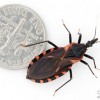 The eastern bloodsucking conenose belongs to the subfamily Triatominae, known as the kissing bugs. Despite their affectionate vernacular name, they are particularly threatening “assassin bugs” who require blood meals to survive and reproduce. They are a known vector of American trypanosomiasis (or Chagas Disease) in South America, a debilitating illness caused by the parasite Trypanosoma cruzi. This disease is a problem in South and Central America and has been detected in the United States, but has not been found in Florida. This 4-page fact sheet was written by John L. Capinera, and published by the UF Department of Entomology and Nematology, November 2013.
The eastern bloodsucking conenose belongs to the subfamily Triatominae, known as the kissing bugs. Despite their affectionate vernacular name, they are particularly threatening “assassin bugs” who require blood meals to survive and reproduce. They are a known vector of American trypanosomiasis (or Chagas Disease) in South America, a debilitating illness caused by the parasite Trypanosoma cruzi. This disease is a problem in South and Central America and has been detected in the United States, but has not been found in Florida. This 4-page fact sheet was written by John L. Capinera, and published by the UF Department of Entomology and Nematology, November 2013.
http://edis.ifas.ufl.edu/in1018
Tag: John L. Capinera
Rat lungworm Angiostrongylus cantonensis (Chen, 1935) (Nematoda: Strongylida: Metastrongylida)
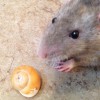 Like many pest and disease problems, rat lungworm has been slowly spreading around the world. First described by Chen from rats in China, the medical significance of this parasite was overlooked until 1944 when it was found infecting humans in Taiwan. Even then, because the report was published in Japanese, its importance remained largely unknown. In 1955, Mackerras and Sandars found this nematode among rats in Brisbane, Australia, and described its life cycle, including the importance of its molluscan intermediate hosts. This 4-page fact sheet was written by John Capinera and Heather S. Walden, and published by the UF Department of Entomology and Nematology, September 2013.
Like many pest and disease problems, rat lungworm has been slowly spreading around the world. First described by Chen from rats in China, the medical significance of this parasite was overlooked until 1944 when it was found infecting humans in Taiwan. Even then, because the report was published in Japanese, its importance remained largely unknown. In 1955, Mackerras and Sandars found this nematode among rats in Brisbane, Australia, and described its life cycle, including the importance of its molluscan intermediate hosts. This 4-page fact sheet was written by John Capinera and Heather S. Walden, and published by the UF Department of Entomology and Nematology, September 2013.
http://edis.ifas.ufl.edu/in1007
Granulate cutworm, Feltia subterranea (Fabricius) (Insecta: Lepidoptera: Noctuidae)
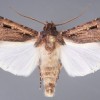 The granulate cutworm, Feltia subterranea (Fabricius) is the most commonly occurring cutworm in Florida, though it is rarely numerous enough to be a major pest. It is nocturnal through most of its life, and lacks distinctive features in the larval and adult stage, so it often is overlooked, and its activities and damage are not fully appreciated. This 4-page fact sheet was written by John L. Capinera, and published by the UF Department of Entomology and Nematology, May 2013.
The granulate cutworm, Feltia subterranea (Fabricius) is the most commonly occurring cutworm in Florida, though it is rarely numerous enough to be a major pest. It is nocturnal through most of its life, and lacks distinctive features in the larval and adult stage, so it often is overlooked, and its activities and damage are not fully appreciated. This 4-page fact sheet was written by John L. Capinera, and published by the UF Department of Entomology and Nematology, May 2013.
http://edis.ifas.ufl.edu/in997
Cornsilk Fly (suggested common name), Euxesta stigmatias Loew (Insecta: Diptera: Otitidae) (EENY224/IN381)
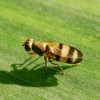 ‘Cornsilk flies’ are attractive, medium to dark metallic green to black colored flies with distinctive wing patterns and wing flapping behavior. They are commonly found throughout Florida’s agricultural communities. Their normally saprophytic life style belies their destructive nature when it comes to their preference for sweet corn ears. Four species of ‘cornsilk flies’ are known to attack corn in Florida: Chaetopsis massyla (Walker), Euxesta annonae (Fabricius), Euxesta eluta Loew, and Euxesta stigmatias Loew. This 8-page fact sheet was written by Gregg S. Nuessly and John L. Capinera, and published by the UF Department of Entomology and Nematology, April 2013. #UFBugs
‘Cornsilk flies’ are attractive, medium to dark metallic green to black colored flies with distinctive wing patterns and wing flapping behavior. They are commonly found throughout Florida’s agricultural communities. Their normally saprophytic life style belies their destructive nature when it comes to their preference for sweet corn ears. Four species of ‘cornsilk flies’ are known to attack corn in Florida: Chaetopsis massyla (Walker), Euxesta annonae (Fabricius), Euxesta eluta Loew, and Euxesta stigmatias Loew. This 8-page fact sheet was written by Gregg S. Nuessly and John L. Capinera, and published by the UF Department of Entomology and Nematology, April 2013. #UFBugs
http://edis.ifas.ufl.edu/in381
Enemigos naturales y control biologico (ENY866/IN977)
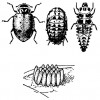 Hay muchos insectos benéficos pero solamente hay algunos que son enemigos naturales de plagas. Los enemigos naturales más comunes de encontrar son: mariquitas/tortolitas, crisopas, antocóridos (Orius), ligaéidos, sírfidos, avispas de agallas, hormigas, avispas parasíticas, moscas parasíticas y ácaros depredadores. La importancia relativa varía de acuerdo con cada insecto plaga, el hábitat y la estación o época del año. This 7-page fact sheet was written by Hugh A. Smith y John L. Capinera, traducido por Ana Lucrecia MacVean, and published by the UF Department of Entomology and Nematology, January 2013.
Hay muchos insectos benéficos pero solamente hay algunos que son enemigos naturales de plagas. Los enemigos naturales más comunes de encontrar son: mariquitas/tortolitas, crisopas, antocóridos (Orius), ligaéidos, sírfidos, avispas de agallas, hormigas, avispas parasíticas, moscas parasíticas y ácaros depredadores. La importancia relativa varía de acuerdo con cada insecto plaga, el hábitat y la estación o época del año. This 7-page fact sheet was written by Hugh A. Smith y John L. Capinera, traducido por Ana Lucrecia MacVean, and published by the UF Department of Entomology and Nematology, January 2013.
http://edis.ifas.ufl.edu/in977
Tobacco Budworm, Heliothis virescens (Fabricius) (Insecta: Lepidoptera: Noctuidae) (EENY219/IN376)
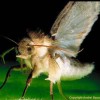 The tobacco budworm, Heliothis virescens (Fabricius), is a native species and is found throughout the eastern and southwestern United States. It is principally a field crop pest, attacking such crops as alfalfa, clover, cotton, flax, soybean, and tobacco. Larvae bore into buds and blossoms (the basis for the common name of this insect), and sometimes the tender terminal foliar growth, leaf petioles, and stalks. This 6-page fact sheet was written by J. L. Capinera, and published by the UF Department of Entomology and Nematology, October 2012.
The tobacco budworm, Heliothis virescens (Fabricius), is a native species and is found throughout the eastern and southwestern United States. It is principally a field crop pest, attacking such crops as alfalfa, clover, cotton, flax, soybean, and tobacco. Larvae bore into buds and blossoms (the basis for the common name of this insect), and sometimes the tender terminal foliar growth, leaf petioles, and stalks. This 6-page fact sheet was written by J. L. Capinera, and published by the UF Department of Entomology and Nematology, October 2012.
http://edis.ifas.ufl.edu/in376
Insecticides and Wildlife (ENY511/IN881)
 When we use chemical insecticides to eliminate problem insects we discover that the effects of insecticides are not always limited to these 6-legged targets. Wildlife, pets, and humans also can be affected by insecticides. So one of the great challenges confronting humans is to develop ways to manage insects without affecting non-target organisms. Learn more in this 16-page fact sheet written by John L. Capinera, and published by the UF Department of Entomology and Nematology, October 2011.
When we use chemical insecticides to eliminate problem insects we discover that the effects of insecticides are not always limited to these 6-legged targets. Wildlife, pets, and humans also can be affected by insecticides. So one of the great challenges confronting humans is to develop ways to manage insects without affecting non-target organisms. Learn more in this 16-page fact sheet written by John L. Capinera, and published by the UF Department of Entomology and Nematology, October 2011.
http://edis.ifas.ufl.edu/in881
Giant African Land Snail in Florida (ENY512/IN904)
 They’re back! In 1966, a child smuggled three giant African land snails into south Florida which were released in their garden. Seven years later, more than 18,000 snails had been found and it took 10 years and $1 million to eliminate them. Florida is once again faced with an invasion by this snail. It feeds on hundreds of different plants and can transmit meningitis and other diseases to humans. Learn more in this 3-page fact sheet written by John L. Capinera and published by the UF Department of Entomology and Nematology, October 2011.
They’re back! In 1966, a child smuggled three giant African land snails into south Florida which were released in their garden. Seven years later, more than 18,000 snails had been found and it took 10 years and $1 million to eliminate them. Florida is once again faced with an invasion by this snail. It feeds on hundreds of different plants and can transmit meningitis and other diseases to humans. Learn more in this 3-page fact sheet written by John L. Capinera and published by the UF Department of Entomology and Nematology, October 2011.
http://edis.ifas.ufl.edu/in904
Dark Rover Ant: Brachymyrmex patagonicus Mayr (EENY498/IN899)
 The dark rover ant is a tiny ant, native to Argentina and Paraguay, that was introduced relatively recently to the United States. It is established in the Gulf states and in some urban areas of Arizona and Nevada. It is a nuisance species because it invades and establishes nests in structures. This 6-page fact sheet was written by David Tamayo, and published by the UF Department of Entomology and Nematology, August 2011.
The dark rover ant is a tiny ant, native to Argentina and Paraguay, that was introduced relatively recently to the United States. It is established in the Gulf states and in some urban areas of Arizona and Nevada. It is a nuisance species because it invades and establishes nests in structures. This 6-page fact sheet was written by David Tamayo, and published by the UF Department of Entomology and Nematology, August 2011.
http://edis.ifas.ufl.edu/in899
Grasshopper Nematode: Mermis nigrescens Dujardin, 1842 (EENY500/IN900)
 These large nematodes can sometimes seen leaving grasshoppers, especially those that have been injured. On rainy mornings in spring or summer they can be found depositing their eggs on leaves for grasshoppers to eat. Because they are so large (up to 160 mm or about 6 inches in length), they attract attention. Learn more in this 5-page fact sheet written by John L. Capinera, and published by the UF Department of Entomology and Nematology, September 2011.
These large nematodes can sometimes seen leaving grasshoppers, especially those that have been injured. On rainy mornings in spring or summer they can be found depositing their eggs on leaves for grasshoppers to eat. Because they are so large (up to 160 mm or about 6 inches in length), they attract attention. Learn more in this 5-page fact sheet written by John L. Capinera, and published by the UF Department of Entomology and Nematology, September 2011.
http://edis.ifas.ufl.edu/in900
Terrestrial Snails Affecting Plants in Florida (EENY497/IN893)
 Most snails are either beneficial or harmless, but a few snails may feed on economically important plants and become pests. The terrestrial species that can become plant pests are discussed in this 12-page fact sheet written by John L. Capinera and Jodi White, and published by the UF Department of Entomology and Nematology, July 2011.
Most snails are either beneficial or harmless, but a few snails may feed on economically important plants and become pests. The terrestrial species that can become plant pests are discussed in this 12-page fact sheet written by John L. Capinera and Jodi White, and published by the UF Department of Entomology and Nematology, July 2011.
http://edis.ifas.ufl.edu/in893
Rosemary Grasshopper Schistocerca ceratiola Hubell and Walker (EENY496/IN894)
 The rosemary grasshopper occurs only in Florida. It is poorly known and rarely seen except by those specifically seeking it out. This 4-page fact sheet an illustrated summary of its appearance and ecology, written by John L. Capinera and published by the UF Department of Entomology and Nematology, July 2011.
The rosemary grasshopper occurs only in Florida. It is poorly known and rarely seen except by those specifically seeking it out. This 4-page fact sheet an illustrated summary of its appearance and ecology, written by John L. Capinera and published by the UF Department of Entomology and Nematology, July 2011.
http://edis.ifas.ufl.edu/in894
Terrestrial Slugs of Florida (Mollusca: Stylommatophora: Veronicellidae, Phylomycidae, Agrolimacidae and Limacidae) (EENY494/IN891)
Most slugs are hermaphroditic, possessing both male and female sex organs. This makes slugs particularly dangerous as invaders because even a single individual that escapes detection can establish a population in a new environment through self-fertilization. This 11-page fact sheet discusses the slug situation in Florida, including problems with slug identification and taxonomy, as well as the behavior, ecology, and management of slugs. Written by John L. Capinera and Jodi White and published by the UF Department of Entomology and Nematology , June 2011.
http://edis.ifas.ufl.edu/in891
EENY483/IN875 European Earwig Forficula auricularia Linnaeus (Insecta: Dermaptera: Forficulidae)
EENY483, a 6-page illustrated fact sheet by John L. Capinera, is part of the Featured Creatures collection. It describes this predatory, omnivorous insect with pincer-like cerci (forceps) –distribution, description and life cycle, behavior, hosts, damage, and management. Includes references. Published by the UF Department of Entomology and Nematology, October 2010.
http://edis.ifas.ufl.edu/in875